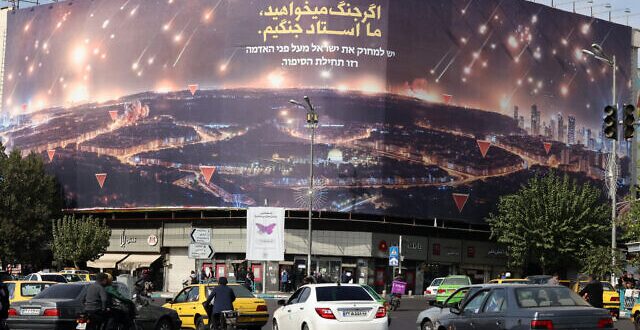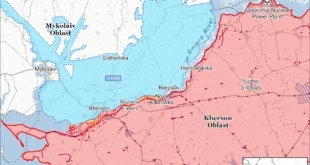NYT: Israel hit secretive Parchin base, S-300 air defenses near Tehran airport; reports say Israel aimed to minimize casualties; Iran says 4 soldiers killed
Iran said Saturday it was obliged to “defend itself” after Israel conducted strikes on military targets throughout the Islamic Republic — an assault that came in retaliation for Tehran’s ballistic missile barrage on the country earlier this month.
“Iran has the right and the duty to defend itself against foreign acts of aggression,” Iran’s foreign ministry said in a statement, citing Article 51 of the United Nations Charter. However, the regime did not immediately vow to respond.
Israel indicated that it was braced for a potential Iranian response but warned Iran against it. “If the regime in Iran were to make the mistake of beginning a new round of escalation, we will be obligated to respond,” IDF Spokesman Rear Adm. Daniel Hagari said on Saturday morning, after the four-hour operation was completed.
Citing the army, Iranian media reported that four soldiers were killed in the overnight strikes. No further details were given.
According to two Iranian officials quoted by The New York Times, one of the sites targeted was the S-300 air defense of Imam Khomeini International Airport near Tehran. (Israel reportedly targeted a Russian-made S-300 air defense system near Iran’s Natanz nuclear site in April.)
At least three Islamic Revolutionary Guards Corps missile bases were targeted in the strikes, according to the unnamed officials, one of whom is a member of the IRGC.
Israeli drones also targeted the secretive Parchin military base on the outskirts of Tehran, the New York Times report added, citing the officials as saying that one drone hit the site while others were downed.
Israel has stated for years that Iran has carried out activities linked to its nuclear weapons program at Parchin, where the UN’s IAEA nuclear watchdog in 2016 reportedly found evidence of nuclear weapons-related activity.
There was no confirmation of the specific target at Parchin, however, and a research fellow at the International Institute for Strategic Studies said it was a plant related to rocket manufacture.
Iran’s military claimed only radar systems were damaged in the strikes.
“Thanks to the timely performance of the country’s air defenses, the attacks caused limited damage and a few radar systems were damaged,” the armed forces general staff said in a statement read out on state television.
“A large number of missiles were intercepted and enemy aircraft were prevented from entering the country’s airspace,” the statement said.
Israeli aircraft were reduced to firing a “small number of long-range missiles with very light warheads from a distance,” inside the US-patrolled airspace of neighboring Iraq, it added.
The general staff held back from any threat of immediate retaliation.
“While reserving its legal and legitimate right to respond at the appropriate moment, Iran is prioritizing the establishment of a lasting ceasefire in Gaza and Lebanon,” it said.
Unprecedented attack
The Israeli operation, hitting targets some 1,600 kilometers (1,000 miles) away, marked an unprecedented attack in terms of its scale, duration and Israel’s immediate acknowledgment of responsibility.
However, Israel did not target nuclear or oil facilities, heeding pressure from the Biden administration. The US, in turn, endorsed the Israeli attack as an act of self-defense, and made clear it was ready to help Israel defend itself against an Iranian response.
The Washington Post quoted an informed source as saying the strike was designed to minimize casualties and to allow Tehran to deny any major damage, preventing an escalation between the countries.
And an Axios report claimed Israel indirectly warned Iran ahead of its airstrikes not to hit back, in an attempt to prevent a spiral into wider conflict. The Israeli message was reportedly passed to Iran via several third parties, including the Dutch foreign minister. “The Israelis made it clear to the Iranians in advance what they are going to attack in general and what they are not going to attack,” one source was quoted as saying.
The office of Prime Minister Benjamin Netanyahu on Saturday night denied this report as “false and absurd.”
Iran indeed appeared to downplay Israel’s strikes, with a source quoted by state media denying the IDF’s announcement that dozens of fighter jets had taken part in the retaliatory attack.
“The reports alleging that 100 Israeli military planes have had a role in the strike are also complete lies, as Israel is seeking to overplay its weak attack,” the source was quoted as saying by Iran’s semi-official Tasnim news agency.
The report also claimed that Israeli jets did not cross into Iranian airspace during the strikes and that they caused only limited damage. Iran’s mission to the UN said the Israeli warplanes attacked from Iraqi airspace, blaming the United States for what it called its complicity.
Footage published by Qatar-funded Al Araby TV purported to show damage from Israeli strikes to a factory in Shamsabad, south of Tehran.
Unverified reports on social media said three workers were killed at the factory, which was said to be involved in the development and production of military drones.
The IDF said it precisely targeted strategic military sites — specifically drone and ballistic missile manufacturing and launch sites, as well as air defense batteries.
Washington and London said they backed Israel’s right to defend itself, notably in the wake of Iran’s attack on October 1, while calling on Iran to de-escalate. Arab nations also urged de-escalation, though many blamed Israel for destabilizing actions.
Waves of strikes
Reports of explosions near Tehran began to emerge around 2:15 a.m. local time, with the Israel Defense Forces quickly releasing a statement confirming that it was attacking, in response to “months of continuous attacks from the Iranian regime against the State of Israel.”
The strikes were carried out in several waves over the course of several hours, in various areas of Iran, with the Islamic Republic closing its airspace for the duration and seemingly showing little ability to counter the assault. Strikes were reported in the Tehran, Karaj, Isfahan and Shiraz areas.
The first wave of attacks apparently targeted Iran’s air defense capabilities, both to ensure the IDF’s freedom of operations during Saturday’s sorties and to lay the ground for further strikes should Iran retaliate. As the campaign was underway, Syrian state media reported that Israel struck several military sites in the south and center of the country, possibly to enable the IAF to operate more freely in Iran.
The next waves hit drone and ballistic missile manufacturing sites — those used in direct Iranian attacks on Israel on April 14 and October 1 — as well as sites used to launch such weapons.
The Israeli military said at 6 a.m. that the assault had been completed, with “all goals achieved” and all aircraft returning safely home. It dubbed the campaign “Days of Repentance,” a reference to the recent Yom Kippur holiday. It said dozens of IAF aircraft, including fighter jets, refuelers and spy planes, participated in the “complex” operation some 1,600 kilometers from Israel.
The military said the strikes had given the IAF “wider freedom of aerial action in Iran” and that it had a broad bank of targets that it could hit in the future if required.
“The regime in Iran and its proxies in the region have been relentlessly attacking Israel since October 7th — on seven fronts — including direct attacks from Iranian soil,” the IDF said. “Like every other sovereign country in the world, the State of Israel has the right and the duty to respond.”
Following the strikes, the IDF said it was holding an assessment on a potential Iranian response to the attack, but as of now, there were no changes to guidelines for civilians. The IDF added that its “defensive and offensive capabilities are fully mobilized,” and that it “will do whatever necessary to defend the State of Israel and the people of Israel.”
Iran had braced for an Israeli reprisal after its latest direct attack on Israel, in which it fired 200 ballistic missiles that sent most of Israel to bomb shelters on October 1, killed a Palestinian man in the West Bank, and caused damage in residential areas and at military bases — although the IDF said that the attack had no operational impact.
Iran said that the attack came in response to strikes in Lebanon that killed Hezbollah leader Hassan Nasrallah and much of the terror group’s senior leadership last month, as well as the killing of Hamas politburo leader Ismail Haniyeh in Tehran in July, which has been widely blamed on Israel despite its silence on the matter.
 Eurasia Press & News
Eurasia Press & News




